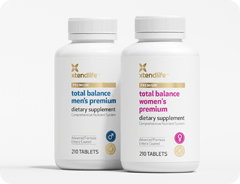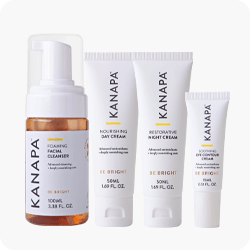Why do you need Omega-3?
Although fat has certainly been demonised in the past, the right types of fats are actually essential for our health. We need fats for the normal production and functioning of cells, hormones, muscles, nerves and organs.
There’s a special group of fats known as essential fatty acids (EFAs), which are particularly important for good health. They are referred to as ‘essential’ because our bodies need them to function properly, and we cannot produce them, meaning they must be consumed through our diet.
EFAs come in two groups: Omega-3 and Omega-6 fatty acids. These two types of fats work hand in hand to help your body mange healthy inflammation, which is a critical part of the immune system. While Omega-6 is important, in excess it can promote inflammation, while Omega-3 helps regulate it.
In the West, we tend to consume too much Omega-6 fats through processed foods and grains, and not enough Omega-3 from oily fish and seafood. The recommended ratio of Omega-6 to 3 is around 2:1 or 4:1, but in the Western diet it is closer to 16:1[2]. Over time, this imbalance in Omega-6 and Omega-3 can create a state of constant unhealthy inflammation, which has been linked to a wide range of ailments, from heart disease and diabetes to asthma and allergies.
As well as regulating inflammation, Omega-3 fatty acids also fulfil a range of other roles in the body, including supporting healthy arteries and blood vessels, promoting healthy triglycerides, thinning the blood, assisting with memory and cognition, and maintaining healthy vision.
How do you increase your Omega-3 intake?
With such a shortfall of Omega-3 in most people’s diets, almost all of us could benefit from increasing our intake. But what’s the best way to increase your intake of Omega-3: diet or supplementation?
According to UK programme Trust Me, I’m a Doctor, both will work. The programme undertook a double-blind, placebo-controlled study to determine the efficacy of dietary intervention and Omega-3 supplementation in adults with low Omega-3 levels.
60 volunteers with low levels of Omega-3 (each having an Omega-3 index of 5% or less, considered to be moderate to high risk for developing a health condition), were divided into three groups, with each group receiving a different intervention:
- Group One was given Omega-3 supplements (totalling 1500mg of Omega-3 per day) and a meal containing white fish twice each week (most white fish contains very little Omega-3)
- Group Two was given a meal containing oily fish twice each week (dark oily fish is high in Omega-3) and a placebo supplement
- Group Three was given two white fish meals each week and a placebo supplement.
After just eight weeks, Groups One and Group Two had increased their Omega-3 index levels from 4-5% to 7-8%, which may significantly reduce their risk of serious illness or heart attack. Group Three (placebo group) experienced negligible change. This indicates that dietary intervention and Omega-3 supplementation can significantly improve blood Omega-3 levels, and within a relatively short time frame.

What’s the difference between EPA and DHA?
If you’ve ever taken an Omega-3 supplement, you’ve probably come across the terms EPA (Eicosapentaenoic Acid) and DHA (Docosahexaenoic Acid). So what does each one do and how do we make sure we’re getting enough?
EPA and DHA are different types of fatty acids, which along with ALA (Alpha linolenic acid) make up the family of Omega-3s. As explained below, each one plays quite a different role in maintaining good health:
1. Eicosapentaenoic Acid (EPA), found in oily fish, is helps to support healthy It is also associated with a number of protective actions in our cardiovascular system.
2. Docosahexaenoic Acid (DHA)is also found in oily fish. Essential for healthy brain development, cognitive function and memory, DHA may supports healthy long-term brain function and can help with learning difficulties, autism, and other conditons. It can also help boost mood and support with the management of stress.
DHA also plays a vital role in maintaining healthy vision. The retina contains very high levels of DHA and animal studies suggest that retinal degeneration might be reduced by dietary intake of DHA.[3] Adequate DHA is essential during pregnancy to ensure the normal development of your child’s retina.[4]
3. Alpha linolenic acid (ALA) is found predominantly in plant foods such flaxseeds and flaxseed oil, pumpkin seeds, walnuts, walnut oil and tofu. Although ALA plays some role in managing inflammation, its effects are minimal compared to EPA and DHA.
Of the three fatty acids, DHA offers by far the greatest health benefits, so it’s important to look for Omega-3 supplements offering high levels of DHA. Many fish oils contain significantly more EPA than DHA, which we consider an the wrong ratio. The human brain is mainly made up of DHA, and DHA has the greatest brain and cardiovascular benefits. Demonstrating its importance, human breast milk contains naturally high levels of DHA.
Pure and Effective Omega 3
Our blends of Omega-3 products are an effective, safe, and sustainable way of getting the essential fatty acids you need for cardiovascular, joint and brain health.
Shop now
Can’t you get enough Omega-3 from flaxseed oil?
Some nutritionists and health companies claim that you can obtain all the Omega-3 you need from vegetarian sources like flaxseed oil, pumpkin seeds and walnut oil. While these foods are a great source of ALA, they do not provide DHA or EPA.
Our ability to convert ALA into DHA and EPA is also extremely poor - especially in men. This means that ALA will not provide the DHA and EPA that is needed.
Women can convert small amounts of the ALA in our diets into EPA. Women convert 21% of the ALA they consume into EPA. Then, women are able to convert an even smaller amount of the EPA they derive from ALA into DHA. About 9% of the EPA women produce from ALA is then converted to DHA.[5]
Men are even less able to convert ALA to EPA, and then to DHA. Men convert only somewhere between 5-8% of the ALA they consume into EPA, and almost none (0%) of this EPA into DHA.
So not only is DHA the most important Omega-3 fatty acid, it’s also the most poorly converted. To obtain sufficient DHA, you must consume plenty of oily fish, and take a quality Omega-3 supplement.
Look for Omega-3 supplements containing at least 500mg combined DHA and EPA per day. [6]
How do you decide between two supplements with similar DHA levels?
Ok, so you’ve found two quality fish oils with comparable DHA levels…how do you decide which one to buy? Here’s a few things to look out for:
1. Evaluate the levels of EPA:Look for the supplement with the highest levels of EPA.
2. Is it all concentrated oil: Quality concentrated fish oil is good, however, the concentration process does remove valuable fractions of the fish oil which are beneficial for our health.
Xtendlife uses a combination of a highly concentrated Tuna oil which is molecularly distilled for the highest level of purity and concentrated to meet our strict standards. The highly concentrated Tuna oil is a combined with refined, non-concentrated natural New Zealand Hoki oil. We use non-concentrated Hoki fish oil in its natural triglyceride form and concentrated Tuna oil, making it highly bioavailable – so you get maximum benefit. This unique “Full Spectrum” oil combines a high level of Omega-3 with the benefits of the full spectrum Hoki oil.
3. Check its origin: Many fish oil suppliers use the cheapest fish available, which may be harvested from polluted waters or contaminated by heavy metals.
Delicate oils are easily damaged by heat and light, meaning many fish oils on the market may be of questionable quality.
Xtendlife’s high DHA fish oil is harvested from regulated, sustainable fisheries, including the Hoki caught from the pristine waters off the coast of New Zealand. The Oxidation Specifications even tighter than the specifications set by the Global Organization for EPA and DHA Omega-3 (GOED). We rigorously check each batch of our fish oil for oxidization and contaminants.
The last word
Omega-3 fatty acids are essential for maintaining good health, but unfortunately many of us don’t consume enough. While taking fish oil supplements is a convenient way to increase your Omega-3 intake, for maximum efficacy, it’s important to choose your supplements carefully. Look for Omega-3 products with high levels of DHA and EPA, that are from a reliable source and come with publicly available proof of the quality. Xtendlife provides detailed specifications and Certificates of Analysis for our products.
References:
[1] 2007 Statistics on CAM Use in the United States. https://nccih.nih.gov/news/camstats/2007
[2] Simopoulos AP1. The importance of the ratio of omega-6/omega-3 essential fatty acids.Biomed Pharmacother. 2002 Oct;56(8):365-79.https://www.ncbi.nlm.nih.gov/pubmed/12442909
[3] Hodge W. et al. Effects of Omega-3 Fatty Acids on Eye Health: Summary. 005 Jul. In: AHRQ Evidence Report Summaries. Rockville (MD): Agency for Healthcare Research and Quality (US); 1998-2005. 117. https://www.ncbi.nlm.nih.gov/books/NBK11888/
[4] Heiting, G. Eye benefits of Omega 3 Fatty Acids.http://www.allaboutvision.com/nutrition/fatty_acid_1.htm
[5] How to determine your optimal Omega 3 needs.https://www.algaecal.com/expert-insights/how-to-determine-your-Omega-3-needs/
[6] BBC 2. How can I get more Omega-3 into my diet and how much difference will it make to my health?
https://bbc.in/2HDLxst


 Supplements
Supplements Superfoods
Superfoods Bundles
Bundles









